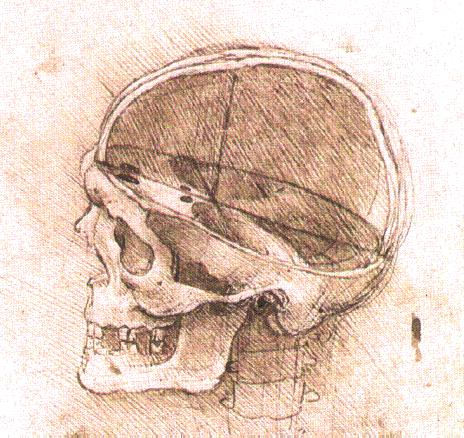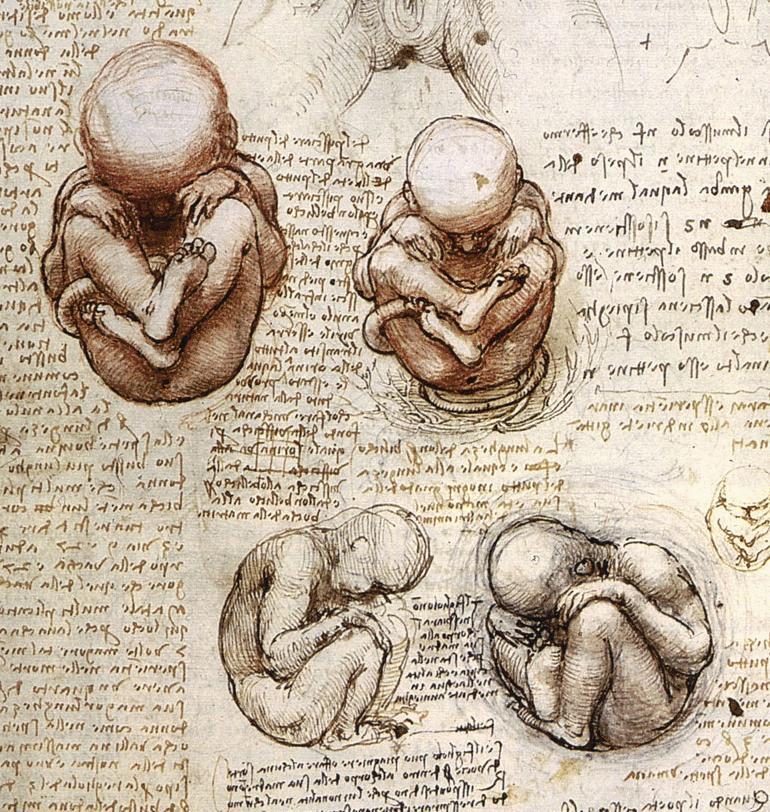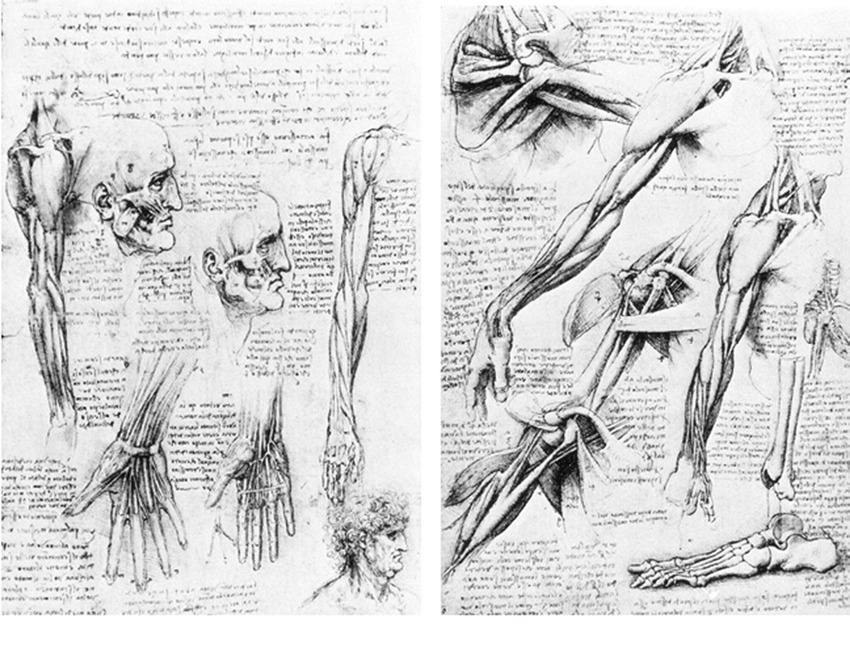
Most Famous Medical Illustrator in History: Leonardo Da Vinci Anatomy
“Da Vinci had come to believe in Alberti’s advice that an artist should build a picture of the body from inside out. First conceiving of the skeleton then the skin then the clothes… He became typically obsessive as he carried forward Alberti’s injunction that artists should conceive a body from inside out. Leonardo wrote, ‘It is necessary for the painter in order to be good at arranging the parts of the body in attitudes and gestures which can be represented in the nude to know the anatomy of the sinews and bones and muscles and tendons.’”
— Walter Isaacson, Leonardo Da Vinci
Most Famous Medical Illustrator in History: Leonardo Da Vinci Anatomy
Leonardo Da Vinci’s Anatomical Drawings
Leonardo’s interest in anatomy began when he was working for the Milanese benefactor, Ludovico. April 2, 1489. His first drawing was a skull. However, because it was illegal and considered sacrilegious to dissect the human body, Da Vinci, while curious about anatomy, did not often have the chance to study anatomy first hand. In the course of his life, he dissected about 30 diseased and healthy human corpses, as a means of discovering human anatomy. Philosophers such as Plato and Aristotle were curious about the body. But they did not dissect it in order to create a realistic model for reference. Consequently, Da Vinci’s renderings are remarkably accurate
None of Leonardo’s astute observations or drawings were ever published during his lifetime due to the taboo about dissecting the body. His notebooks were not really known until 250 years after his death or popular until 1965.


Source: http://www.visi.com/~reuteler/leonardo.html {{pd}}Category:Leonardo da Vinci

Source: http://www.visi.com/~reuteler/leonardo.html {{pd}}Category:Leonardo da Vinci






The 500 year old drawing above is Leonardo da Vinci’s description of the heart he dissected of a recently deceased 100 year old man. It is the first known description of cardiac disease, in which he noted that the arteries may be clogged if they collect debris. Da Vinci also drew the valves of the heart and noted how blood flowed through the aorta to the heart and how with this pulse, the valves opened and closed by way of currents in the blood and the strength, and how blood flowed through the heart as a result of these currents. His observations were so accurate that only with modern MRI technology did the genius of his observations become clear. Da Vinci also observed that the heart is a muscle and that it does not warm the blood, which was not well understood at the time. He noted the four chambers of the heart and that the heart beat of the left ventricle is related to the pulse of the wrist. Da Vinci explored not only the human heart, but also the pig heart.

















Leonardo da Vinci, The Bones and Muscles of the Shoulder. Pen and ink with wash over black chalk, circa 1510-1511. Royal Collection, The Windsor Castle







Da Vinci’s Love of the Rational Human Form
Leonardo Da Vinci made extensive, almost obsessive measurements of the human form, noting thousands of ratios between various body parts in various standing and sitting positions. To see a beautifully documented description of his observed proportions, visit the Artist’s Network page on Da Vinci proportions, an analysis very thoroughly explored, and a direct translation of Da Vinci’s notes.
Vitruvian Man
Vitruvian Man. drawn in 1490, is s special example of Da Vinci and his time. Da Vinci, a true Renaissance man, explored many fields as a sculptor, painter, writer, inventor, mathematician, engineer, architect, and anatomist. It is the view at this time that all natural phenomena can be explained with math. And while the principle is remarkably true. It also proved untrue in some remarkable ways, such as Galileo forcing a geometry on the movement of planets. , though not always accurate, to represent the human body, an inherently non-formulaic or mathematically precise form, and render it in a mathematical way. Here is a great video to explain this perspective.
While Vitruvian man is not a precise representation of how the human form behaves, we still find it beautiful. And Da Vinci’s effort to render the world in a predictably proportioned way is one of the core aspirations of his anatomy notebooks. These notebooks are filled with notes on proportion.

“The man who blames the supreme certainty of mathematics feeds on confusion, and can never silence the contradictions of sophistical sciences which lead to an eternal quackery.” -Da Vinci
“There is no certainty in sciences where one of the mathematical sciences cannot be applied, or which are not in relation with these mathematics.” – Da Vinci













Natural and Scientific Illustrations and Explorations of Da Vinci
Although I did not find an example of Da Vinci










Da Vinci’s Anatomy of Objects as related to His Anatomical Explorations
These Illustrations show Da Vinci’s love of mechanics. I included them in my human anatomy collection because they reveal a love of the “inner workings” of objects. This is the same love that a medical illustrator embraces in everyday drawing. And I believe Da Vinci’s love of anatomy go hand in hand with this curiosity for mechanics:







As a great artist, Leonardo had two advantages over his contemporary anatomists. First of all, as a sculptor, engineer, architect, he had an intuitive understanding of form — when he dissected a body, he could understand in a very fluid way how the different parts of the body fit together, worked together. And then, having made that understanding, as a supreme draftsman, he was able to record his observations and discoveries in drawings of such lucidity, he’s able to get across the form, the structure to the viewer in a way which had never been done before and, in many cases, has never been surpassed since.
Leonardo intended to publish his drawings as an illustrated treatise on human anatomy, but when he died in 1519, his anatomical papers were buried amongst his private possessions and vanished from public sight. In the early 1600s, around 600 of his surviving drawings were bound in a single collection and by the end of the century, they mysteriously made their way to the Royal Collection. Leonardo da Vinci: Anatomist gathers 90 of these seminal drawings, contextualized in a discussion of their anatomical significance. Accompanying the books is an iPad app, presenting 268 pages of Leonardo’s notebooks in magnificent high resolution.
Nature Video was invited to Windsor Castle to see some of Leonardo da Vinci’s anatomical drawings. The drawings show that Leonardo did more than dabble in the sciences; he carried out experiments and made staggering medical discoveries which could have transformed the study of anatomy in Europe — had they not languished unpublished for centuries. In this video, Senior Curator Martin Clayton shows us three of Leonardo’s most intriguing anatomical studies. The drawings in this video will be part of an exhibition at The Queen’s Gallery in Buckingham Palace from 4 May to 7 October 2012 http://www.royalcollection.org.uk/exh… Martin has also written a commentary for Nature’s Books & Arts section: Leonardo’s anatomy years http://www.nature.com/uidfinder/10.10…
_____________________________________
Laura Maaske, MSc.BMC.
Biomedical Communicator
Medical Illustrator
Medical Legal Illustrator
Medical Animator
Health App Developer















